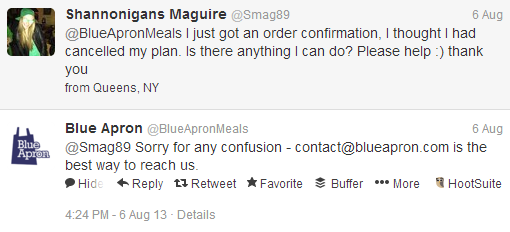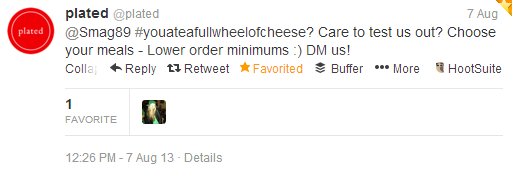Facebook creeping, Twitter stalking, Instagram spying: Whatever you call it, we all do it and we do it frequently (the average American spends nearly 16 minutes of every hour on social media sites). When we put our lives on the Internet for all to see, we are saying we want to be seen, we want to be heard, and in most cases we want to express some emotion. You may be thinking that the aforementioned social activities are reserved for looking up your ex or an old classmate from the comfort of your couch, but social stalking has evolved. As a matter of fact, it may not even be fair to call it “stalking” anymore (I understand the word has somewhat of an ominous connotation). Instead, let’s call it “active listening.”
Active listening has been proven to drive sales for many brands. In fact, 36 percent of marketers have found a customer via Twitter, and analysts say that Facebook is the most effective platform to get consumers talking about products. Now, back away from your second-cousin-twice-removed’s vacation photos and start putting your “stalking skills” to good use for your brand! Here are three ways social stalking active listening can bring positive buzz–and even new business–to your company.
1. Keep your friends close and your enemies closer.
As social media managers, we’re constantly monitoring the conversation about our brands, engaging with our fans and followers, and providing customer service, but we could be (and should be) doing more. While paying attention to your fans is special and ultimately good for business, being aware of what people are saying to and about your competitors is also important.
Recently, I tweeted at Blue Apron. A delivery had gone through that I had not intended to order, so I immediately took to Twitter to resolve the issue. The following social media exchange is the reason why I am now switching from Blue Apron to Plated:
I’m always extremely polite when asking for help or complaining AND, in this case, I even added a smiley. However, Blue Apron wasn’t charmed and lifelessly directed me to its email address. A few moments later I received another notification and discovered that something called “Plated” had tweeted at me (and apparently had done its research.)
If you follow me, you know that I am a lover of movie quotes (if you don’t, what are you waiting for?). Plated not only reached out to satisfy me when Blue Apron could not, it read my Twitter bio and made its tweet personal, quoting Anchorman. To make a long story short, Plated had me at #youateafullwheelofcheese.
I give you this example because you should also be keeping an eye on the competition. You may even get a few loyal consumers to switch teams. It’s as simple as actively searching for users who are tweeting at or about your “enemies,” and then reaching out (Tweetdeck is a great listening tool). This process isn’t as easy on Facebook–mostly because it’s frowned upon to comment on competitors’ posts acting as a brand page, but also because a lot of people who may be talking about you or the competition keep their posts private.
2. Beware of gossip.
The grapevine is a dangerous place for brands. Often, the conversation that is going on about your brand on social isn’t going on with you brand, so you have little to no control over what’s being said (especially if it’s false… shudder), right? WRONG, so wrong. Sure, the complainers, haters, and rumor-starters may not be mentioning your brand’s handle or even hashtagging your name, but that doesn’t mean they are lost in limbo. Actively search for non-hashtagged use of your brand name, nickname, or, more commonly, misspellings. When you reach out to people talking about your brand, without them mentioning you, it shows that you truly care about your company’s social media identity. This also helps to find and solve customer service issues before they escalate.
Not only will you be able to conquer the sub-tweeters of the Internet, but you may also be able to find and eliminate impersonation accounts. For instance, this whole “United Airlanes” thing could have been discovered a lot sooner.

3. Gather intelligence.
As I mentioned earlier, when Plated reached out to me, it crafted a very personal response. It proved that the brand had taken the time to find out about me, before I was even a customer. As a brand’s social media manager, it is important to be invested in your fans’ likes, dislikes, interests, and feelings. This will not only make your consumers more interested in your brand, but it will help you to better understand your customers and what drives them to purchase your product.
On Twitter: Not everyone has a bio on Twitter; you may have to delve a little deeper to find out what makes someone tick. Check out the user’s favorites or follows to get a feel for their personality and interests.
On Facebook: Yes, many Facebook users have private accounts. However, there tend to be a few things you can learn just by looking at a profile. Is their photo a selfie or a group shot? Is there a pet or animal in the photo? Is it an Instagram photo? This can help you decide things like the age or lifestyle of the consumer. Use this to get on their level when responding, and they will be more likely to respond and engage further (especially if they reached out initially with a complaint).
On bit.ly: Did you know you can now add “feelings” to shortened Bitly links? Yep! Fans and foes alike can now share your content with a custom URL that reflects their opinion. Keep an eye out for oppos.es and loath.es URLs that are linking to your site. This simple “feeling” attached to a link can give you a lot of perspective on the sharer’s immediate reaction. Another bonus of Bitly feelings is deciphering a seemingly sarcastic tweet/post. If the link says “loathes” and the text says “What a great article,” you’ll finally know where your brand stands.






